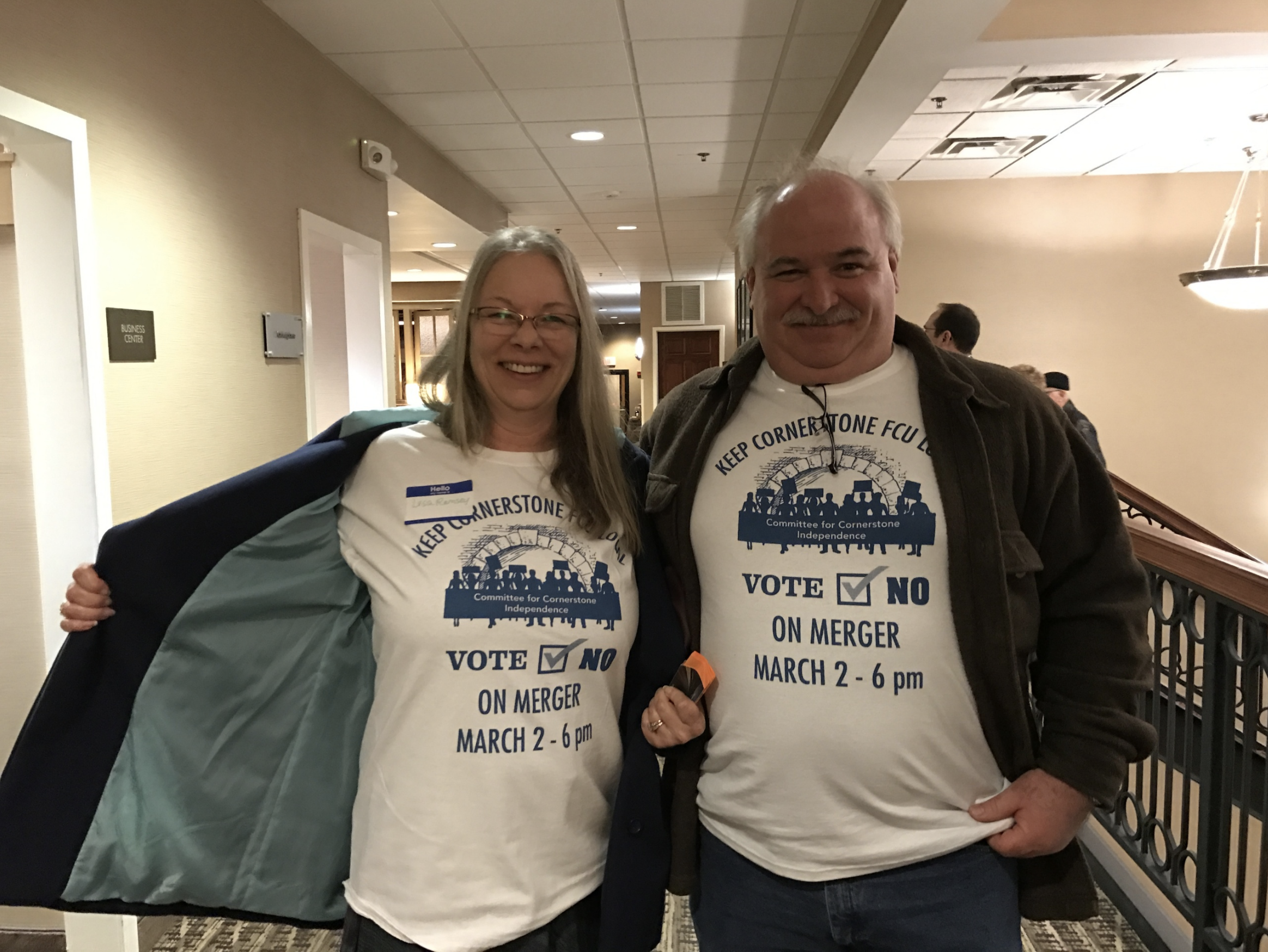(Note: This analysis of Space City’s merger is in two parts. Part I follows with the overall summary and Part II with additional details)
America’s tax-exempt, non-profit, democratically governed credit union system is at a crossroads. Bank competitors and some analysts are questioning whether the movement has lost its core purpose.
The example below of self-dealing, conflicts of interest, lax board oversight and member manipulation is the latest example of internal corruption in the $2.3 trillion cooperative system. These mergers, marked by executive cash outs, are becoming more common. State and federal regulators seem oblivious or powerless to stop this internal pillaging.
On May 14, the 12,000 members of Houston’s Space City CU will cast their final votes to transfer all control of their 60-year old $142 million credit union, with 14.6% net worth, to the $4.8 billion Houston based TDECU. The voting enddate was set in the official Notice of Meeting of the Members of Space City CU dated March 28, 2025, and mailed to all member-owners.
This so- called merger is just the most recent example of leaders taking advantage of their position for self-enrichment. Five Space City executives are giving themselves 57% of the $11,750,208 equity distribution described in the Meeting Notice. The President would receive $4 million (34%) of the $11.8 million payouts and the Chief Operating Officer $2,250,000 (19% in distributions from the members’ collective net worth.
The top three insiders will divide $6.750 million for an average of $2.250 million while the 12,000 plus members whose loyalty built the credit union will average $412.
Even though the Notice states the Board “approved” these special payments to five people (one employee joined in 2022), these deals were arranged by the two CEO’s.
This is the September 2024 initial video released by the CEO’s side by side announcing and selling their deal together with a closing handshake. However, the details of the special “bonus” distributions were not sent to members until the March 28, 2025 Notice or six months after this initial public announcement.
CEO Rohden’s Performance Record
Especially questionable are the actions of Craig Rohden who has been CEO for 30 years. The board claims to “honor his outstanding performance.” His record as CEO is at best underwhelming and more recently, marked by annual losses. In the past two years the credit union reported negative net income of $611,670 for 2023 and $30,398 in 2024.
Following the 2023 loss, according to Space City’s IRS 990 filing for that year, Rohden was paid a total of $280,562 which included a bonus $46,186 and contributions to a retirement plan of $11,604. Additionally, the credit union had a split dollar life insurance plan with a balance due of $3.275 million which would fully vest in the proposed merger. The cash benefits, not disclosed, can often be taken tax free in the future.
However, this performance charade goes back further. In the latest call report March 31, 2025 the credit union’s total net worth is $19.4 million or 14.6% of assets. Of this amount 61% or $11.9 million is from “equity acquired in mergers.” Only 39% is retained earnings from the 30 years of Rohden’s tenure.
Space City lists four mergers resulting in the collective $11.9 million addition to its net worth for free. The largest gain was in the 2022 merger with Brazosport Teachers FCU (BTFCU). In BTFCU’s March 2022 Member Merger Notice, it disclosed that its entire reserves of $8.2 million were being added to Space City’s existing $9.2 million equity while paying the owners nothing from their collective savings.
It also said the combination would manage approximately $154 million in assets serving 12,564 members. In the two and half years since this merger, Space City’s assets have fallen by $20 million to total $134 million and membership has decreased by 500 (data as of March 2025). The reason for this dramatic loss of shares, loans and members is described in a comment by a former BTFCU member on Space City’s merger page at NCUA:
Hester Wende: I am against this merger for 2 reasons. First, members of the now combined Teachers Federal Credit Union with Space City Credit Union were made numerous promises and assurances which were all fabricated. None of the promised items happened and our service has significantly declined. Student accounts were closed because they didn’t meet the standards of Space City Credit Union. Second, TDECU history over the past 10 years is horrible – numerous data breaches have occurred causing untold financial consequences to members. Their customer service is worse than Space City Credit Union.
Looking at the merger documents, it appears that this merger is all about the current President and Vice Presidents receiving a very significant buyout at the expense of Member’s earnings.
Her concerns about TDECU are addressed in my analysis below.
In this equity presentation of “retained earnings” versus “acquired in merger,” only 39% of Space City’s net worth is from the Rohden’s operational performance. Rather growth has come from convincing other credit unions to transfer their firm’s entire assets to his control. The last three year’s financial record clearly shows a runoff and decline across all assets and share accounts under Rohden’s management.
The Final Deal
Now CEO Rohden wants to make one more big deal, only this time it is to “sell” the credit union he has led for 30 years. But unlike his four acquisitions where the CEO’s received little or nothing. he wants his own Golden Parachute at a minimum of $4.0 million.
In addition to the Notice’s misleading justification of Rohden’s “outstanding performance,” two other reasons are equally nonsensical. The Member Notice states Rohden “will not be employed post merger with TDECU and will receive a lump sum of $3.5 million which is the estimated compensation had he remained with Space City until retirement.”
This is the art of the flimflam. The CEO negotiates the transfer of the credit union’s entire operations to a third party, retires early when he could have continued working and then wants to be paid for not working!
Even more specious is this distribution: TDECU will pay a lump sum of $250,000 per year for a total of $500,000 in consideration for a two-year non-compete, non-solicit agreement with his compensation.”
Even though CEO Rohden has never worked at TDECU, he is paid for a non-complete agreement. The term non-compete refers to a firm’s internal employees who may have proprietary knowledge to prevent their taking that information to a competitor. For 30 years Space City and TDECU served the same market. Now he gets paid for a “non-compete” while unemployed?
This upside down reasoning is just a verbal camouflage to cover up a payoff for Rohden’s delivering the credit union’s entire resources plus its brand to TDECU’s control.
There was a similarly worded justification explaining the $350,000 two-year non-compete for COO Nikki Moore as part of her $2.250 million merger payoff. She again has never worked in TDECU.
These so called “non-compete payment” are from TDECU’s member reserves, not Space City’s. These bonus payments to two key players who arranged and approved this free transfer of all Space City’s resources are by the credit union receiving this largess.
The CEO and directors of both boards who approved these payments should be wise to review their fiduciary responsibilities, alongside their legal counsel.
Lack of Board Oversight and Due Diligence
The dubious financial performance history of Space City under CEO Rohden continues in these merger justifications and payouts. Instead of being stewards of the member-owners’ funds, the merger terms reveal self-enrichment. Rohden’s role is especially suspect. He negotiated the terms as CEO, received the largest payments from both credit unions and then recommended his board approve the transaction.
Space City board chair Mick Lay, who signed the official Member Notice, joined the board in 1975. The Treasurer Robert Sander joined in 1980. This is a board that has failed in its basic fiduciary duties of care and duties of loyalty. They have abandoned any pretense of stewardship in their oversight responsibilities.
What’s Next
Should this merger proceed as announced it will be another nail in the coffin of credit unions as immune from the greed and excesses of private enterprise. While the industry may be rich in its trillions of assets, it is poorer in soul and purpose. And it is those values that were supposed to enrich members and their communities, not self-serving insiders dividing the spoils from merger deals.
To stop these credit union predatory actions will take courage from persons in positions of responsibility, public transparency in the media, and most of all, members speaking up to oppose this hijacking of their cooperatively owned financial institutions.
The Rest of the Story in Part II
Following are four analyses of merger details that show the questionable nature of this proposal.
- Buying the Yes vote. How the member bonus distribution is structured to incent their approval independent of their support for the credit union.
- Using the names, logos and reputation of over 50 Houston area businesses, non- profits and public firms to endorse Space City Credit Union (and then TDECU) and its services for their employees. Each organization has just one vote. But a No would send an important message.
- What the members should know about TDECU as the new organization managing their assets including the credit union’s recent financial trends and its intent to buy the $1.2 billion Sabine State Bank headquartered in Louisiana.
- The regulators’ responsibility for approving the merge.
Part II: Four Additional Areas for Member-owners’ Attention
- The Process to Incent Member-Owners to Approve the Merger
Undermining the member vote process is simple. Vote for the merger and you will receive a minimum $100 if your account is less than $289 (as of March 2024), and a maximum of $1,000. If you vote no, you will get nothing.
What makes this strategy so transparent is the strange cutoff points for each of the three bonus levels:
Under $289.27, member receives $100.
Under $2,892.68, member receives 34.6% of their March 2024 balance
Over $2.892.68, member receives $1,000
What the Notice fails to disclose is how many voters are in each category. I presume this precise division, down to the penny, means there are a majority of votes (one person one vote) in smaller balance accounts. This is a great vote buying strategy, but it was nothing to do with rewarding those member-owners whose participation contributed the most to make the credit union successful.
The average share balance held by the 12,140 members is approximately $9,500. As in most financial firms, 20% or fewer of members will hold 80% or more of total deposits. The bonus dividend is not based on members’ financial support. The purpose is to incent small balance members to get $100 each for approving the merger of a credit union in which they barely participate.
We know the board and CEO are aware of paying bonuses on relationships is the normal practice. This example is from its December 28,2023 special dividend: a $1 million dollar bonus dividend payout to its loyal members. . . The bonus, which is a combination of Bonus Dividends ($750,000), Loan Interest Refunds ($175,000), and Checking Rewards Points ($75,000), will be distributed proportionally to all eligible members based on their qualifying deposit balances and activity throughout the year.
The only qualifying activity in this distribution of members’ collective reserves is to vote Yes to approve the merger. Vote No, and you get nothing.
- Using Sponsors’ Reputations to Endorse the Credit Union
At least 55 Houston Area companies, unions, and non-profits have endorsed Space City for their employees to join and support. Each of these sponsoring organizations’ reputation is used to promote the credit union and its actions.
As stated on the Space City website, these Platinum Partners can provide your employees with access to a wide range of affordable financial products and services and a clear path to financial freedom.
The sponsors’ logos on the credit unions web page include: GE Water and Power, Houston Freightliner, Houston Ballet, Houston Housing Authority, Westbury Christian School and dozens more local organizations.
As stated in the merger FAQ’s Businesses with a unique Tax ID number will be able to cast a vote on behalf of their organization.
When these sponsoring organizations vote or are asked by employees whether they should support the merger, their own reputations will be on the line. Would they support this kind of activity if this were in their own organizations?
- What Should Members Know About TDECU?
Included in the Member Notice was a September 30, 2024, financial statement with just balance sheets for each credit union and their combined accounts. Because of the multiple distributions to members and Space City’s senior executives, the combined net worth of 9.84% is less than each credit union’s pre-merger net worth.
The reasons offered for the merger can be summed up in one word: More. More branches, products, services, technology, cost savings and employee opportunity. There was not a single concrete example to document one member benefit.
Right now, every Space City member is eligible to join TDECU without a merger. Why give up a locally focused independent credit union with higher capital ratios so the 12,000 owners can now be a part of a 385,000 member organization? TDECU reports a potential market of over 30 million. Space City members and employees’ control and influence is now 100%; in this merger their role is would be 3%, or insignificant
But the most critical fact about TDECU is not size, but its performance and business direction. Bigger does not mean a better member experience. TDECU’s CEO assumed office in June 2022. For the full years 2023/24 through the first quarter 2025, TDECU’s share and loan growth have flat-lined, employee count is down 56 (from 868), and membership is off by 1,000 (from 385.8K).
What’s up is delinquency from 1.54% to 2.01%, and full year charge offs which have risen from $43.4 million to $53million. The loan allowance coverage ratio from loss reserves is at .56% versus a national average of 164.3%.
TDECU’s growth has stalled, and earnings are in decline. Full year earnings fell from $32.9 million in 2023 to $11.6 million in 2024. In the first quarter of 2025 TDECU reported a loss of $35,476.
But the most critical question about joining with TDECU is not mentioned at all. Prior to the September 2024 joint merger statement, TDECU announced it was purchasing Sabine State Bank and Trust Company on April 30, 2024. This $1.2 billion bank is headquartered in Many, LA. It is 120 years old and operates 51 branches across Louisiana and East Texas. The merger would add about 90,000 new members. The joint press release says Sabine “specializes in commercial loans with industry concentrations in oil and gas, forestry, timber and agriculture.”
TDECU’s justification in the release states: “Sabine’s strong commercial operations will further diversify the credit union’s loan concentration and support TDECU’s overall growth strategy.”
TDECU is using tens of millions of their members’ collective reserves to pay out the owners of Sabine Bank to acquire its business and operations. If this same business logic were applied to the Space City transaction, then the member-owners of the credit union should be receiving their entire book value ($19.4 million) or more), not the paltry $5 million (25%) distribution offered.
The April 2024 joint bank purchase announcement of a “definitive acquisition agreement” was to be completed early in 2025. Over a year later, there have been no further public updates. If this purchase has been put on hold by regulators or other circumstances, then Space City members should know why before they decide whether they want to be part of this new strategy of TDECU.
4.What is the Regulators’ Responsibility?
This proposed Space City merger, according to the joint press release, requires regulatory approvals: The transaction is anticipated to be completed later this year, subject to receiving all regulatory approvals.
The two regulators are the NCUA which insures the credit union shareholders and the Texas Credit Union Commission, which charters and has primary supervisory authority. Both regulators have seen the Member Notice with its misinformation, disinformation, and inadequate facts which member-owners were sent to make an informed decision.
NCUA bylaws state CU boards “have fiduciary responsibility to vote for measures in members’ best interests,” (CU Times March 20,2007)
A December 18, 2007 CU Times report on the attempt by Wings FCU to pay Continental FCU members $200 each to approve a merger. NCUA stopped this effort as explained in the article:
“ . . .credit union boards have an essential role in determining whether a merger is beneficial to the credit unions and their members, said NCUA Chairman JoAnn Johnson at an April 5 Massachusetts Credit Union Governmental Affairs Day Conference.
“The agency held to its position that it would ensure that all statutory and regulatory requirements are being followed including an assessment of the accuracy of all advertising and representations being made about the merger . . .. NCUA said it was prepared to address any inadequacies or insufficiencies that threaten member protection, transparency and fairness.
“In the end, it was NCUA that put a stop to Wings Financial’s merger campaign. On April 20, the agency ruled that the $200 payments Wings Financial had offered to Continental’s membership should a merger go through were impermissible under the Federal Credit Act.
In this case TDECU is paying the arrangers of the merger, the CEO and COO of Space City $850,000.
Today two of the three NCUA board members have been fired by President Trump. This means the Texas regulator will have a primary role whether this self-serving effort, fraught with conflicts of interest, self-dealing and insufficient information is a valid process for member-owner decision making.
The Credit Union Commission’s decision will have significant ramifications for Space City’s 12,000 credit union members, the greater Houston business community, and the system’s reputation for integrity in Texas.



